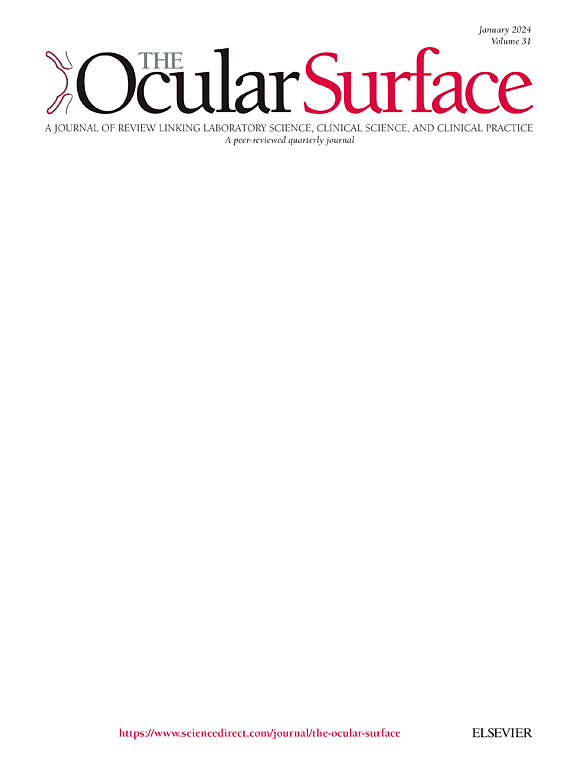“En bloc” combined 270-degree keratolimbal allograft with central lamellar keratoplasty for severe limbal stem cell deficiency secondary to mustard gas exposure
IF 5.9
1区 医学
Q1 OPHTHALMOLOGY
引用次数: 0
Abstract
Background
Severe limbal stem cell deficiency (LSCD) resulting from chronic and delayed-onset mustard gas keratopathy (MGK) presents substantial management challenges. This article introduces an “en bloc” surgical procedure combining a 270-degree keratolimbal allograft (KLAL) with central lamellar keratoplasty (CLK) as a novel approach to treat this condition.
Methods
A retrospective case series was conducted at Labbafinejad Medical Center in Tehran, Iran, from 2002 to 2019, including 13 eyes from 13 male patients diagnosed with chronic and delayed-onset MGK. Each patient underwent the combined 270-degree KLAL and central LK procedure. A 270-degree peritomy, sparing the superior quadrant, was performed. A lamellar dissection using a crescent blade and a blunt Melles dissector was carried out, extending 2 mm from the limbus. Fresh donor tissue with intact 270-degree limbo-conjunctiva, obtained from a whole globe, was prepared to match the recipient bed and sutured into place. Postoperative outcomes and success including ocular surface integrity, graft longevity, and best-corrected visual acuity (BCVA), were evaluated.
Results
The average follow-up period was 87.6 ± 49.8 months. Surgical success was achieved in 12 of 13 patients (92.3 %). Preoperative BCVA improved from 1.07 ± 0.24 (approximately 20/250) logMAR to 0.63 ± 0.30 (approximately 20/80) logMAR postoperatively. One patient experienced immune rejection of the KLAL graft, while two patients had episodes of corneal rejection, all successfully managed with aggressive immunosuppressive therapy.
Conclusions
The “en bloc KLAL + CLK” procedure demonstrates promising long-term outcomes in managing chronic and delayed-onset MGK associated with severe LSCD. This approach offers advantages, including reduced surgical complexity, minimized antigenic load, and better anatomical alignment, leading to successful ocular surface restoration and improved visual acuity.
"整体 "联合 270 度角膜同种异体移植术和中央板层角膜移植术,用于治疗芥子气暴露导致的严重角膜干细胞缺乏症。
背景:慢性和迟发性芥子气角膜病(MGK)导致的严重角膜缘干细胞缺乏症(LSCD)给治疗带来了巨大挑战。本文介绍了一种结合270度角膜同种异体移植术(KLAL)和中央板层角膜移植术(CLK)的 "整体 "手术方法,作为治疗这种疾病的新方法:2002年至2019年,伊朗德黑兰拉巴菲内贾德医疗中心开展了一项回顾性病例系列研究,其中包括13名被诊断为慢性和迟发性MGK的男性患者的13只眼睛。每位患者都接受了 270 度 KLAL 和中央 LK 联合手术。手术进行了 270 度周边切除术,并保留了上象限。使用新月形刀片和钝性梅勒斯剥离器进行板层剥离,剥离范围为距角膜缘 2 毫米处。从一个完整的球体上获取带有完整的270度边缘结膜的新鲜供体组织,准备好与受体床相匹配的组织并缝合到位。对术后效果和成功率进行了评估,包括眼表完整性、移植物寿命和最佳矫正视力(BCVA):平均随访时间为 87.6 ± 49.8 个月。13 位患者中有 12 位(92.3%)手术成功。术前 BCVA 从 1.07 ± 0.24(约 20/250)logMAR 提高到术后的 0.63 ± 0.30(约 20/80)logMAR。一名患者出现了 KLAL 移植免疫排斥反应,两名患者出现了角膜排斥反应,但都通过积极的免疫抑制治疗得到了成功控制:结论:"en bloc KLAL + CLK "手术在治疗与重度LSCD相关的慢性和迟发性MGK方面具有良好的长期疗效。这种方法的优势包括降低手术复杂性、最大限度地减少抗原负荷以及更好的解剖对位,从而成功恢复眼表并提高视力。
本文章由计算机程序翻译,如有差异,请以英文原文为准。
求助全文
约1分钟内获得全文
求助全文
来源期刊

Ocular Surface
医学-眼科学
CiteScore
11.60
自引率
14.10%
发文量
97
审稿时长
39 days
期刊介绍:
The Ocular Surface, a quarterly, a peer-reviewed journal, is an authoritative resource that integrates and interprets major findings in diverse fields related to the ocular surface, including ophthalmology, optometry, genetics, molecular biology, pharmacology, immunology, infectious disease, and epidemiology. Its critical review articles cover the most current knowledge on medical and surgical management of ocular surface pathology, new understandings of ocular surface physiology, the meaning of recent discoveries on how the ocular surface responds to injury and disease, and updates on drug and device development. The journal also publishes select original research reports and articles describing cutting-edge techniques and technology in the field.
Benefits to authors
We also provide many author benefits, such as free PDFs, a liberal copyright policy, special discounts on Elsevier publications and much more. Please click here for more information on our author services.
Please see our Guide for Authors for information on article submission. If you require any further information or help, please visit our Support Center
 求助内容:
求助内容: 应助结果提醒方式:
应助结果提醒方式:


